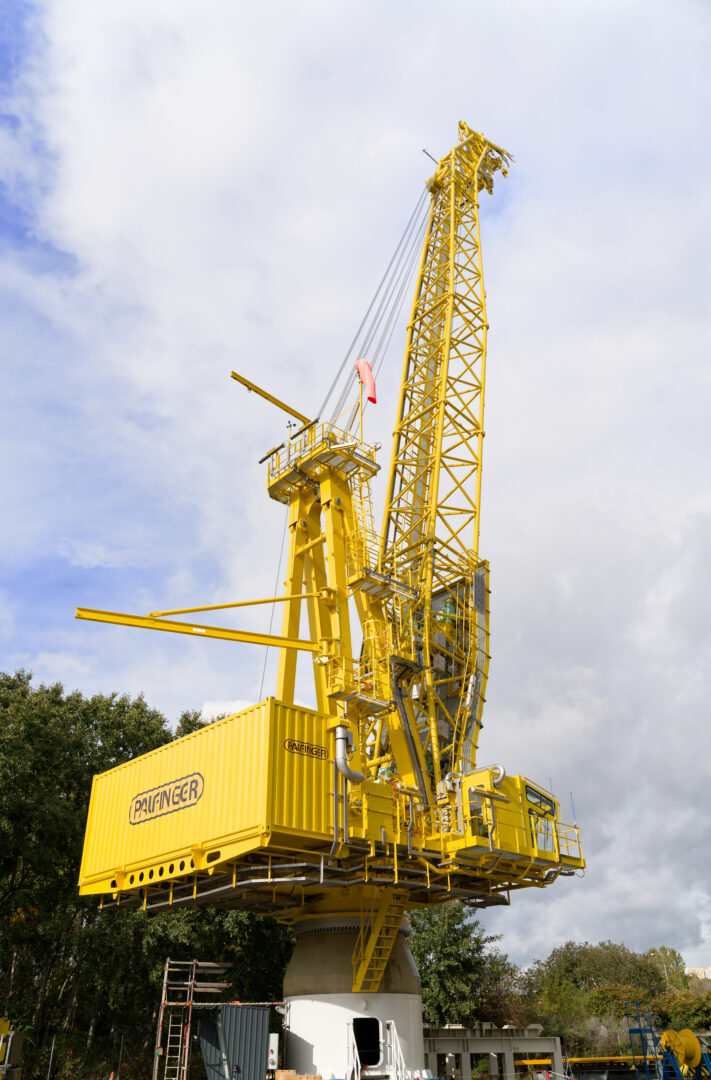Last Updated on January 9, 2025 by PALFINGER
In late 2021, PALFINGER MARINE secured the contract to supply two DKW 1600e fully electric wire-luffing lattice boom offshore cranes. These cranes are set to be installed on the Petrobras P78 Floating Production Storage and Offloading (FPSO) unit, located in the Búzios oil field in Brazil. We took the milestone of the two modular offshore cranes passing their Factory Acceptance Test (FAT) as an opportunity to check in on the status of this landmark project that may surprise you in terms of innovation level.
Kjetil Roksvåg, Global Sales Manager at PALFINGER MARINE, still remembers the negotiation phase and is in no doubt about why we were selected to supply the subjected cranes: “I firmly believe that our work in crane modularization made all the difference. We were able to respond swiftly and attentively throughout the entire clarification and contract negotiation phase. Finally, the PALFINGER brand and our deliveries of fully electric offshore cranes to the Norwegian continental shelf played a significant role as well.”
PIONEERS IN MODULAR WIRE LUFFING OFFSHORE CRANES
Michal Rzytelewski, our dedicated Project Manager, is eager to highlight the pioneering innovations: “Drawing from our extensive experience with our DKWe cranes, we decided to significantly upgrade this flagship range by completely remastering the underlying modular design – mechanically, electrically, and in terms of software. Our Research & Development team spent two years perfecting the design of the main steel elements of the slewing column, the boom sections, and the A-frame before we even signed the contract. While previous wire luffing cranes featured similar components, we have never achieved this level of interchangeability before. The main steel elements are now fully modular, meaning they are standardized across all cranes of this size. Only secondary elements, like for example the platforms, are customized for each project. This development accelerates the design process immensely and will become the new standard,” Michal explains.
In addition to this innovative modularity, the crane’s responsiveness is unparalleled. Its electric motors directly move the elements, eliminating the need to power up pumps or build hydraulic pressure. The torque is instantly transferred to the machinery, making it highly efficient and responsive. Thanks to the absence of noisy hydraulic pumps and the use of electric drives the crane is incredibly silent in operation.
The crane is undeniable state-of-the-art technology.
CHALLENGES MASTERED HEAD-ON
Quite apart from the contract being negotiated during the Covid pandemic, the project encountered several other hurdles. “We faced challenges due to a disrupted supply chain, which meant that it took more than a year to source all the necessary components. And then there was the welding situation,” Michal points out. We were forced us to find and qualify a new supplier. The innovative nature of the new DKWe cranes made this task even more difficult. The top-tier, high-quality steel used for the boom makes it incredibly difficult to weld,” Michal adds. Yet, PALFINGER MARINE is known to rise to a challenge and finally found a Polish welding partner who delivered outstanding work in close collaboration with our in-house welding engineer Adam Mioduszewski. “Generally, the whole project is a true team effort, with over 30 skilled PALFINGER MARINE employees contributing their expertise and consistently outperforming in their respective fields”, Michal points out.
SIGNIFICANT MILESTONES REACHED
“Our first milestone was the delivery of the pedestal adaptor already in May 2022. The adaptor was designed from scratch to meet our client’s specific requirements. It showcased an impressive speed in design, fabrication, and delivery. The assembly, significantly impacted by the welding situation, took us 11 months,” Michal recalls. “The FAT itself – which doesn’t yet include the anticollision system to be conducted offshore – took five full days for each crane, but the internal testing and commissioning took much longer,” he reveals. When asked to elaborate, Michal is quick to provide an example: “We installed the slewing column on the test stand in February, but the boom only arrived mid-July. Our commissioning and software teams had to work tirelessly to bring the crane to life on schedule.” Needless to say, they were successful.
Mid of November our cranes were brought from our production site in Gdynia to the port for their trip to Singapore. This complex operation, that involved moving the 61-meter-long cranes, each weighing approximately 190 tons, was executed using three Self Propelled Modular Transporters (SPMTs). It took place during the night. “We had to close an entire street, managed the dismantling of local infrastructure, including traffic lights and signs and lowered the cranes’ A-frames to pass bridges with mere inches of clearance. The trip to the ship was challenging, but these moves are always incredibly exciting to witness.”
Watch the video created by Michal to get a sense of this extraordinary transport event:
How many more such thrilling projects can Michal expect? Kjetil is confident that there are many more to come down the line: “The FPSO market looks very promising for the next decade. While Brazil, Guyana, and Surinam are perceived as main market drivers, we also expect a fair amount of activity surrounding the African continent.” It’s a good time to be an innovator like PALFINGER MARINE.
Interested in more exciting case studies about PALFINGER MARINE projects from around the globe? Make sure to check back on our blog on a regular basis – maybe even to hear more from Michal and Kjetil on this project down the line.




